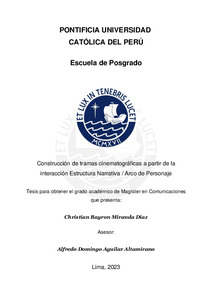| dc.contributor.advisor | Aguilar Altamirano, Alfredo Domingo | |
| dc.contributor.author | Miranda Diaz, Christian Bayron | |
| dc.date.accessioned | 2023-07-20T13:56:02Z | |
| dc.date.available | 2023-07-20T13:56:02Z | |
| dc.date.created | 2023 | |
| dc.date.issued | 2023-07-20 | |
| dc.identifier.uri | http://hdl.handle.net/20.500.12404/25404 | |
| dc.description.abstract | El presente estudio propone la construcción de tramas cinematográficas a partir de la
interacción del arco de personaje y la estructura narrativa con el propósito de ser un punto de
referencia para guionistas, directores y productores cinematográficos, así como de los jurados
de los concursos de cine promovidos por el Estado. Para ello se analiza la construcción de
dos películas peruanas del género de thriller ganadoras de los fondos del Ministerio de
Cultura peruano: Perro guardián (Caravedo & Higashionna, 2014) y Magallanes (Del Solar,
2015), dos relatos que coinciden temáticamente. Sus protagonistas son dos exmilitares que
luchan por reinsertarse en la sociedad y buscan redimir los delitos de sus pasados
traumáticos.
La metodología empleada tiene un paradigma interpretativo basada en la
hermenéutica de Paul Ricoeur. El enfoque es cualitativo y emplea la técnica del análisis diegético narrativo en ambas películas. Para la selección de la muestra, se han utilizado las
principales inflexiones del relato, identificadas con la técnica del análisis semiótico de Claude
Bremond y el análisis estructural de los relatos de Roland Barthes.
Los principales resultados identifican las fallas estructurales del film Perro guardián,
cuya trama prioriza su carácter dimensional y retórico, que se apoya en las convenciones del
género del thriller psicológico, en desmedro del impulso dramático. En el caso de
Magallanes, la trama presenta un balance entre su carácter dimensional y direccional, es
decir, la acción está motivada por los conflictos internos del protagonista, lo que genera una
mayor unidad interna en su trama. A partir de los hallazgos, es importante comprobar si este patrón de construcción de
tramas se replica en otras películas nacionales. Su comprensión puede dar luces de cómo
construir tramas que conecten emocionalmente con las audiencias, algo que necesita con
urgencia la cinematografía local para generar una industria sólida. | es_ES |
| dc.description.abstract | The present study proposes the construction of film plots from the interaction of
character arc and narrative structure with the purpose of being a point of reference for
screenwriters, directors and film producers, as well as juries of film contests promoted by the
state. To this end, the construction of two Peruvian films of the thriller genre, winners of
funds from the Peruvian Ministry of Culture, are analyzed: Perro guardián (Caravedo &
Higashionna, 2014) and Magallanes (Del Solar, 2015), two stories that coincide thematically
Its protagonists are two former military men who struggle to reintegrate into society and seek
to redeem the crimes of their traumatic pasts.
The methodology used has an interpretive paradigm based on the hermeneutics of
Paul Ricoeur, the approach is qualitative and employ the technique of narrative diegetic
analysis in both films. For the selection of the sample, we have used the main inflections of
the story, identified with the technique of semiotic analysis of Claude Bremond and the
structural analysis of the stories of Roland Barthes. The main results identify the structural flaws of the film Perro guardián whose plot
prioritizes its dimensional and rhetorical nature that relies on the conventions of the
psychological thriller genre to the detriment of the dramatic impulse. In the case of
Magallanes, the plot presents a balance between its dimensional and directional nature, that
is, the action is motivated by the internal conflicts of the protagonist, which generates a
greater internal unity in its plot.
Based on the findings, it is important to see if this pattern of plot construction is
replicated in other national films; understanding it can shed light on how to build plots that connect emotionally with audiences, something that local filmmaking urgently needs to
generate a solid industry. | es_ES |
| dc.language.iso | spa | es_ES |
| dc.publisher | Pontificia Universidad Católica del Perú | es_ES |
| dc.rights | info:eu-repo/semantics/openAccess | es_ES |
| dc.rights.uri | http://creativecommons.org/licenses/by-nc-nd/2.5/pe/ | * |
| dc.subject | Cine peruano--Narración (Retórica) | es_ES |
| dc.subject | Ricœur, Paul--Crítica e interpretación | es_ES |
| dc.subject | Hermeneútica | es_ES |
| dc.subject | Guión cinematográfico | es_ES |
| dc.title | Construcción de tramas cinematográficas a partir de la interacción Estructura Narrativa / Arco de Personaje | es_ES |
| dc.type | info:eu-repo/semantics/masterThesis | es_ES |
| thesis.degree.name | Magister en Comunicaciones | es_ES |
| thesis.degree.level | Maestría | es_ES |
| thesis.degree.grantor | Pontificia Universidad Católica del Perú. Escuela de Posgrado. | es_ES |
| thesis.degree.discipline | Comunicaciones | es_ES |
| renati.advisor.dni | 06741771 | |
| renati.advisor.orcid | https://orcid.org/0000-0002-8818-7185 | es_ES |
| renati.author.dni | 43874867 | |
| renati.discipline | 322027 | es_ES |
| renati.juror | Dettleff Pallete, James Anthony | es_ES |
| renati.juror | Aguilar Altamirano, Alfredo Domingo | es_ES |
| renati.juror | Aybar Cabezudo, Oscar Alfredo | es_ES |
| renati.level | https://purl.org/pe-repo/renati/level#maestro | es_ES |
| renati.type | https://purl.org/pe-repo/renati/type#tesis | es_ES |
| dc.publisher.country | PE | es_ES |
| dc.subject.ocde | https://purl.org/pe-repo/ocde/ford#5.08.00 | es_ES |







